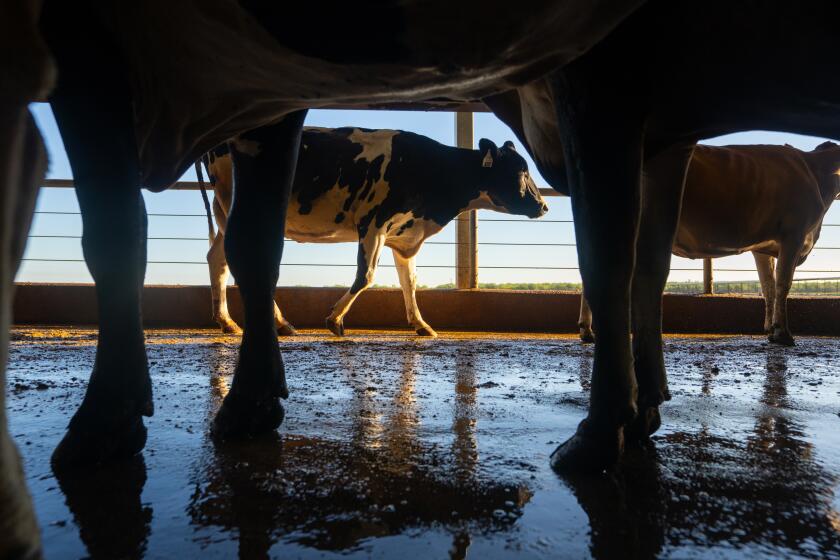
- Share via
Nearly a year after a wild bird infected with H5N1 avian flu presumably passed its viral baggage to a dairy cow in the Texas panhandle — which has subsequently led to the infection of more than 700 herds nationwide and sickened at least 35 dairy workers — the nation’s agriculture department announced Friday that it will sample the nation’s milk supply to test for the virus.
The federal order requires dairy farmers to collect and share raw milk samples for testing — if requested — by the U.S. Department of Agriculture. It also lays out a staged testing strategy that will allow the federal agency to track and monitor the disease.
The National Milk Testing Strategy, which the new milk testing regimen is called, “is a critical part of our ongoing efforts to protect the health and safety of individuals and communities nationwide,” according to a statement from Xavier Becerra, the U.S. secretary of Human and Health Services.
The California raw milk producer who has issued several product recalls for bird flu has has applied for an advisory role at the Food and Drug Administration.
The new order will initially apply to six states: California, Colorado, Michigan, Mississippi, Oregon and Pennsylvania.
The goal, according to the statement, is to rid the nation’s dairy herds of the disease — an achievement few infectious-disease researchers or virologists think is possible, at least any time soon.
“I very much support efforts to expand bulk milk testing, as it is currently the primary way we are finding outbreaks on farms,” said Jennifer Nuzzo, a professor of epidemiology and director of the Pandemic Center at Brown University School of Public Health. “This is helpful, but not fully adequate to protect farmworkers who are being exposed to the virus. If we were serious about protecting farmworkers, this would be implemented immediately and expanded to include all states.”
Government health officers insist that the virus poses a low risk to the public. However, some experts warn that nearly all the conditions needed for the virus to develop a threatening mutation are now present in many dairy farms: lax testing protocols; close, unprotected contact between humans and animals; a general failure to take the threat seriously enough; and the approach of human flu season.
While California, Colorado and Michigan have all reported positive herds, the three others named in the order have not. Testing regimens and investigations have already been underway in the infected states — as well as in Pennsylvania, which in late November, began its own “Precautionary Bulk Milk Testing at Processing Plants” program.
In California, the largest dairy-producing state in the nation, the order will have little impact, officials say. “We are already doing this,” said Steve Lyle, a spokesman for the California Department of Food and Agriculture.
The virus has burned through more than half of California’s 900 dairy herds and infected 31 dairy workers in the state.
Michael Payne, a researcher and outreach coordinator at the Western Institute for Food Safety and Security at UC Davis, said he suspects the order “might provide some useful epidemiological data in other states” but California’s testing is already “so robust and aggressive.” He doesn’t anticipate that it will substantially change “our understanding of the disease spread in the state or how to manage it.”
The plan was first announced in October, and was to have been implemented in November; testing will begin the week of Dec. 16, according to the statement.
While Oregon has not had a H5N1 outbreak in dairy cows, it has reported the disease in commercial poultry, wild birds and, last month, two pigs. There are about 220 dairy herds in the state.
Mississippi has roughly 50 herds, with each farm averaging 149 cows.
The Scripps Research Institute finding counters prevailing thought that the virus would require multiple mutations before it poses a threat to public health.
In the plan’s first stage, testing will occur at all dairy processing facilities within a given state, allowing the federal agency to determine if and where the virus is residing. The next stage will allow the federal agency to drill deeper by moving the testing to bulk tanks.
If the virus is found, the third stage goes into action, triggering an even more granular investigation by identifying farms and herds that are positive — allowing for “rapid response measures,” including biosecurity programs such as movement controls and contact tracing.
If, however, no virus is found in a state, bulk tank testing frequency will progressively decrease — going from weekly to monthly to quarterly, assuming the state’s tests remain negative.
Finally, there is the fifth stage, known as “Demonstrating Freedom from H5 in U.S. Dairy Cattle.”
That’s when, according to the statement, states can begin more periodic sampling and testing “to illustrate long-term absence from the national herd.”
As the virus has continued to spread among the nation’s dairy herds, a number of experts have urged more robust testing, tracking and genetic sequencing of the pathogen.
“Eradication of H5N1 is likely impossible in the short term,” John Korslund, a retired U.S. Department of Agriculture veterinarian epidemiologist, wrote in a blog post about the agriculture agency’s plans to begin bulk testing. “The shorter-term goals should be to minimize replication through movement biosecurity and (hopefully) vaccination and then maximize transparency” by sampling and publishing genetic sequencing of infected animals.
He said while the virus may not economically devastate U.S. dairy production, if left “unmonitored and uncontrolled” it could threaten the nation’s beef, poultry and swine industries.









